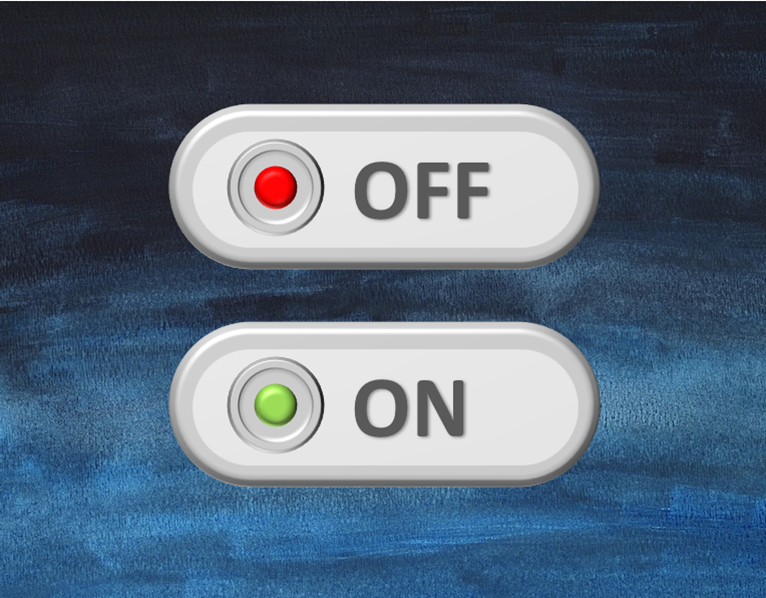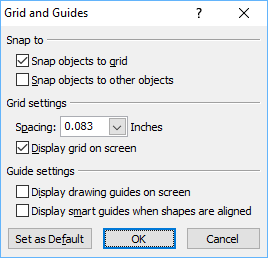Turn Off or Disable PowerPoint's Snap to Grid
by Avantix Learning Team | Updated October 22, 2021
Applies to: Microsoft® PowerPoint® 2010, 2013, 2016, 2019 and 365 (Windows)
When you move an object on a PowerPoint slide, the object will normally snap to an invisible grid by default. This can be irritating so you may want to temporarily override the snap to grid behavior or turn off snap to grid permanently.
Recommended article: How to Align Shapes, Pictures and Other Objects in PowerPoint
Do you want to learn more about PowerPoint? Check out our virtual classroom or live classroom PowerPoint courses >
Temporarily override snap to grid using Alt
To move an object and temporarily override "snap to" settings, simply press Alt while dragging the object. Ensure that you are dragging the object by a border, not a handle.
This Alt + drag trick also works in combination with the Ctrl key when dragging so if you press Alt + Ctrl and drag an object, a non-snapping copy of the selected object will be created.
Temporarily override snap to grid by nudging
If you select an object and then press Ctrl + an arrow key, the object will be nudged in the direction of the arrow and will not snap to grid.
Permanently turn off snap to grid
You can turn off snap to grid permanently for a presentation using the Grid and Guides dialog box:
- Click the View tab in the Ribbon.
- In the Show group, click the dialog box launcher on the bottom right corner of the group. A dialog box appears. Alternatively, you can right-click in a slide and select Grid and Guides from the context menu.
- Uncheck Snap objects to grid. If you click Set as Default, snap to grid will be turned off for all presentations. Otherwise, snap to grid will be turned off only for the current presentation.
- Click OK.
Below is the Grid and Guides dialog box:
Each method has its benefits and you'll be able to place an object exactly where you want it.
Subscribe to get more articles like this one
Did you find this article helpful? If you would like to receive new articles, join our email list.
More resources
10 Great PowerPoint Drawing Tricks and Shortcuts
3 Ways to Change the Font on All Slides in PowerPoint
Free PowerPoint Countdown Timer Slides to Download
How to Group and Ungroup in PowerPoint (with Shortcuts)
How to Hide and Unhide Slides in PowerPoint (with Shortcuts)
Related courses
Microsoft PowerPoint: Intermediate / Advanced
Microsoft PowerPoint: Design for Non-Designers
Our instructor-led courses are delivered in virtual classroom format or at our downtown Toronto location at 18 King Street East, Suite 1400, Toronto, Ontario, Canada (some in-person classroom courses may also be delivered at an alternate downtown Toronto location). Contact us at info@avantixlearning.ca if you'd like to arrange custom instructor-led virtual classroom or onsite training on a date that's convenient for you.
Copyright 2024 Avantix® Learning
You may also like
How to Insert or Type E with an Accent Mark in PowerPoint (È, É, Ê, Ë, è, é, ê, or ë)
You can insert or type e with an accent mark in PowerPoint using built-in tools or keyboard shortcuts (including Alt code shortcuts). The letter e can be inserted with an accent in both upper or lower case in text boxes or placeholders on slides, the slide master or layouts. The following are common accents in upper or lower case – È, É, Ê, Ë, è, é, ê, or ë.
How to Fade a Picture or Part of a Picture in PowerPoint (Using a Gradient)
You can fade a picture in PowerPoint by drawing a rectangle shape on top of the picture and then filling the rectangle with a gradient from opaque to transparent. This technique is often used to fade an image into the background of a slide. Since the rectangle is placed on top of the image and then text may be placed on top of the rectangle, you may need to reorder the objects.
How to Lock an Image, Shape or Other Object in PowerPoint
You can now lock an image, shape or other object in PowerPoint. Objects can be locked in Normal View or Slide Master View. Only PowerPoint 365 users can lock objects to prevent moving and resizing. This is helpful if you want to select and move other objects on the slide or prevent others from moving or resizing an object. You can lock items using the context menu or the Selection Pane.
Microsoft, the Microsoft logo, Microsoft Office and related Microsoft applications and logos are registered trademarks of Microsoft Corporation in Canada, US and other countries. All other trademarks are the property of the registered owners.
Avantix Learning |18 King Street East, Suite 1400, Toronto, Ontario, Canada M5C 1C4 | Contact us at info@avantixlearning.ca








